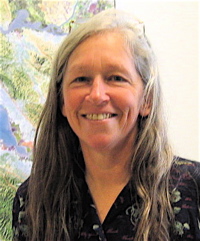No, Dr. Peggy Hellweg of UC Berkeley’s Seismological Laboratory can’t predict the Bay Area’s next major earthquake. However, she did go over why scientists think the Hayward fault could get shaken up pretty soon. That was part of her talk during March’s enrichment lecture for Chabot volunteers and their guests.
Earthquakes occur when the edges of the major tectonic plates that make up the earth’s crust stick, rub or break off against each other. There are three different types of tectonic plate boundaries: transform, where the plates are moving past each other horizontally, convergent, where they move towards each other, and divergent, where the plates are moving apart. Most of California’s faults, including the large San Andreas fault, are transform faults. The North American plate, where our continent resides, is moving slowly westward, while the Pacific plate, adjacent to the west, is moving slowly eastward.
Until about 30 million years ago, the land that is now California was within a subduction zone, where part of one plate moves underneath another and becomes buried. The present-day San Andreas fault system formed from the tension created as the North American plate moved northwest.
Geologists figured out that continents moved over time by observing changes in the magnetic fields of rocks. When rocks heated above a certain temperature cool, they take on the magnetic field orientation present around them, which depends on where they are located in relation to the Earth’s magnetic poles. So when some rocks in a certain area have a different orientation from nearby rocky matter, we can infer that they have moved in from elsewhere. Researchers estimate that the earth’s tectonic plates move at about five centimeters per year.
Our written history contains records of earthquakes in the Northern California area going back to 1857, with major quakes in that year and also in 1868, 1872, and of course 1906. The 1868 earthquake took place along the Hayward fault, which now poses a threat because the plates have moved enough over time to put stress on the nearby rock. Geologists can estimate earthquake risk because they can see how far the plates have moved and know about how much strain different kinds of rock can take before the earth will shake and readjust its position. Dr. Hellweg said there was a 99 percent probability of a quake above magnitude 6.7 somewhere in California within the next 30 years. However, as she reminded us, the average person is more likely to die crossing the street than in an earthquake.
Earthquakes tend to occur in two stages. First, the P-waves, or pressure waves, which move up and down, and then the S-waves, or shear waves, from side to side. When animals seem to sense earthquakes before humans do, they are likely feeling the initial P-waves. Quakes are also measured in terms of magnitude, a single number per quake referring to the length of the affected area, the duration of the quake, and how much energy was released. A quake’s intensity reflects how strongly we could feel the quake in various locations. So, a quake with a 7.0 magnitude with an epicenter at the heart of San Francisco would be felt with greater intensity closer to the city.
Dr. Hellweg finished her talk by going over California’s extensive network of seismic stations to detect, observe and record earthquakes. California currently has more than 3,000 seismic stations, which get plenty of use in areas prone to small quakes, such as Cape Mendocino and the Long Valley Caldera. Geologists now can give the public a three-second warning before a quake (five seconds for the police and eight for BART train operators).
‘Wherever there are mountains, there are faults,’ Dr. Hellweg reminded us near the end of her lecture. Her comment underscored how the solid earth beneath us is actually in constant motion, and the same forces that pushed up huge mountain ranges are still at work today.
You may read more about Dr. Hellweg’s work and the UC Berkeley Seismological Laboratory here: http://seismo.berkeley.edu/blog/seismoblog.php/2012/03/15/about-peggy-hellweg

